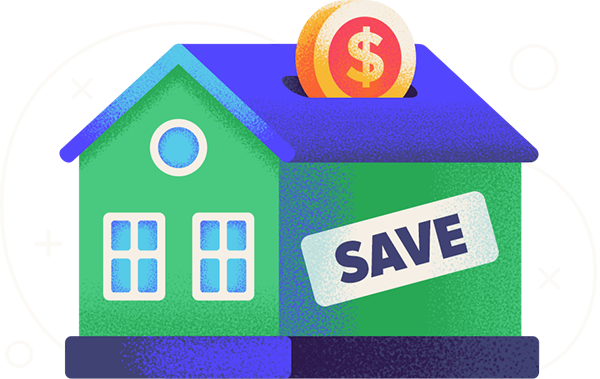To save for a house, you should figure out how much you need to save for things like the down payment and closing costs, look for down payment assistance programs, and cut unnecessary spending. You should also create a budget to help you identify areas to cut back on spending and track your progress toward your goal.
Saving as much as you can for a house can help make sure you don’t come up short when you’re trying to close on your dream home. This is more common than you might think. About 2 in 5 buyers said the costs to close on their home were higher than they expected, according to a study done by Zillow.
How Much to Save for a House?
Experts recommend saving up 25% to 30% of the home’s purchase price before buying a house – to cover things like the down payment, closing costs, and moving expenses. It is also a good idea to have some money set aside for any unexpected costs, like home repairs.
Down payment: Ideally you want to put down at least 20% of the purchase price to avoid having to pay mortgage insurance with some types of loans.
Closing costs: Closing costs are the upfront fees you have to pay when purchasing a home, such as the loan origination fee and the appraisal fee. Closing costs are usually around 2% to 6% of the home’s purchase price.
Moving expenses: Moving expenses can include the cost of renting a moving truck, hiring movers, getting packing supplies, and temporary lodging if you are doing a long-distance move. The average cost to hire movers is $1,712, according to home services company Angi.
Cash reserves: Lenders may require you to have a cash reserve of up to six months’ worth of mortgage payments, so they know you have the ability to make mortgage payments if you lose your job.
Savings for other expenses: You’ll want to have savings to cover things like new furniture or unexpected costs like repairs.
Between the down payment, closing costs, and a range of other expenses, buying a home is one of the costliest purchases you can make. Even saving 20% for the down payment might seem impossible, with the median sale price in the U.S. being more than $400,000. That’s why some buyers may look to other resources outside of their savings to come up with the money for a down payment on a house.
Try WalletHub's mortgage calculator
How Buyers Save for a Down Payment
It’s most common for home buyers to use their savings for the down payment on a home, according to a survey done by Zillow. But some buyers use the proceeds from selling their previous home, get a loan from friends or family members, or even pull money out of their retirement account. Below, you can see the percentage of home buyers who’ve used each method to fund their down payment.
- Savings: 41%
- Sale proceeds from previous home: 25%
- Gifts from friends and family: 7%
- Loans from friends and family: 6%
- Retirement fund: 6%
- Investments: 7%
- Other: 8%
It’s generally not recommended to use your retirement savings to purchase a home as you may face a costly penalty fee for making an early withdrawal and lose out on the gains the money would have made if it was still in the account. Luckily, there are more options you can try if you want to save for a house.
9 Tips for Saving for a House
1. Create a Budget
A budget can help you plan out your spending, so you can reduce how much you spend on non-essential expenses and have more money to put toward saving for a home. To make your home budget, follow these basic steps:
- Add up all your sources of income, so you know how much you get paid every month.
- Make a list of all your expenses.
- Determine how much money you want to save for a house.
- Analyze your income and expenses to see how much you can realistically set aside each month to save for a house.
- Review your budget every week or month to track your progress.
Learn more about making a budget.
2. Reduce Unnecessary Spending
Cutting back on your discretionary spending can help you free up some extra money that you can put toward the purchase of a home. Some things you can do to reduce unnecessary spending include:
- Cooking at home instead of dining out at restaurants.
- Lowering your energy consumption at home to reduce your utility bill.
- Using coupons at the grocery store.
- Avoiding impulse buys.
- Canceling subscriptions you are no longer using.
Learn more ways to stop spending money.
3. Pay Down Debt
The interest on your debt can eat away at your savings, leaving you with less money for a house. By paying more than your minimum monthly payment, you can become debt-free sooner and reduce the amount of interest you pay overall. You can also reroute the money that you would have used to pay the interest to your savings.
In addition, having less debt is good for your credit. Lenders look at your debt-to-income ratio to determine your ability to afford a home. You have the best odds of getting approved for a mortgage when your debt-to-income ratio is below 36%.
You can use WalletHub’s debt payoff plans to find the quickest and fastest way out of debt.
4. Increase Your Income
The more money you make, the easier it can be to save for a house. You can give your income a boost by asking for a raise, working overtime, getting a side gig, or switching to a job with higher pay.
5. Save Any Windfalls
You should put any extra money that you get toward your house savings. These windfalls can include:
- Raises or bonuses from work
- Your tax refund
- Any cash gifts from friends or relatives
- An inheritance
6. Automate Your Savings
You can set your savings on autopilot by setting up automatic recurring transfers from your checking account to your house savings fund, so you don’t have to remember to do it every month.
7. Earn Interest on Your Savings
Put your house savings into an interest-earning account that allows your money to grow faster while it sits in the account.
Examples of Interest-Earning Accounts
- Traditional savings accounts
- High-yield savings accounts
- Money market accounts
- Certificates of deposit
8. Use a Budgeting App
A budgeting app, like the WalletHub app, can help you keep track of your budget. For example, WalletHub lets you sync your financial accounts to automatically track your expenses, so you don’t have to do it manually. You can also easily monitor your progress toward saving for a house.
9. Look for Assistance With Your Down Payment
You can see if any close relatives would be willing to loan you money for a down payment on a house. Also, your state or local government may have first-time home buyer programs that can offer down payment grants and help with closing costs. You can ask your mortgage lender if they know of any programs, or you can use a service such as downpaymentresource.com to find local programs in your area.
To learn more, check out WalletHub’s guide on budgeting for a house.
How Much Should You Spend on a Mortgage?
One of the most common rules to follow when deciding how much to spend on a mortgage is the 28% rule, which requires spending no more than 28% of your income on your mortgage. Staying within this limit can help you live comfortably while still having funds to pay your other necessary expenses, such as food, utilities, and transportation.
To follow the 28% rule, you multiply your monthly income by 0.28 to determine the maximum amount you can pay per month toward a mortgage. For example, if you make $5,000 a month, you can afford to pay $1,400 per month for a mortgage. Your mortgage payment covers your principal and interest, and it may include things like property taxes and homeowners insurance.
Learn more about how much to spend on a house.


WalletHub experts are widely quoted. Contact our media team to schedule an interview.